Legal and Sociopolitical Impacts: Fire Service Case Studies Analysis
VerifiedAdded on 2019/11/14
|23
|7200
|242
Report
AI Summary
This report delves into the legal and social implications within fire and emergency services through the analysis of various case studies. The report examines critical issues such as fire safety inspections, code enforcement, the Fireman's Rule, and the application of Standard Operating Procedures (SOPs). Case studies explore topics including the consequences of inadequate safety measures, legal liabilities in mutual aid scenarios, age discrimination in mandatory retirement, and workplace discrimination. The report provides valuable insights into best practices, legal liabilities, and recommendations for fire departments to improve their operations, safety protocols, and legal compliance. The report covers topics on how to avoid legal liabilities and discusses the political and social impacts of legal issues within the fire service.
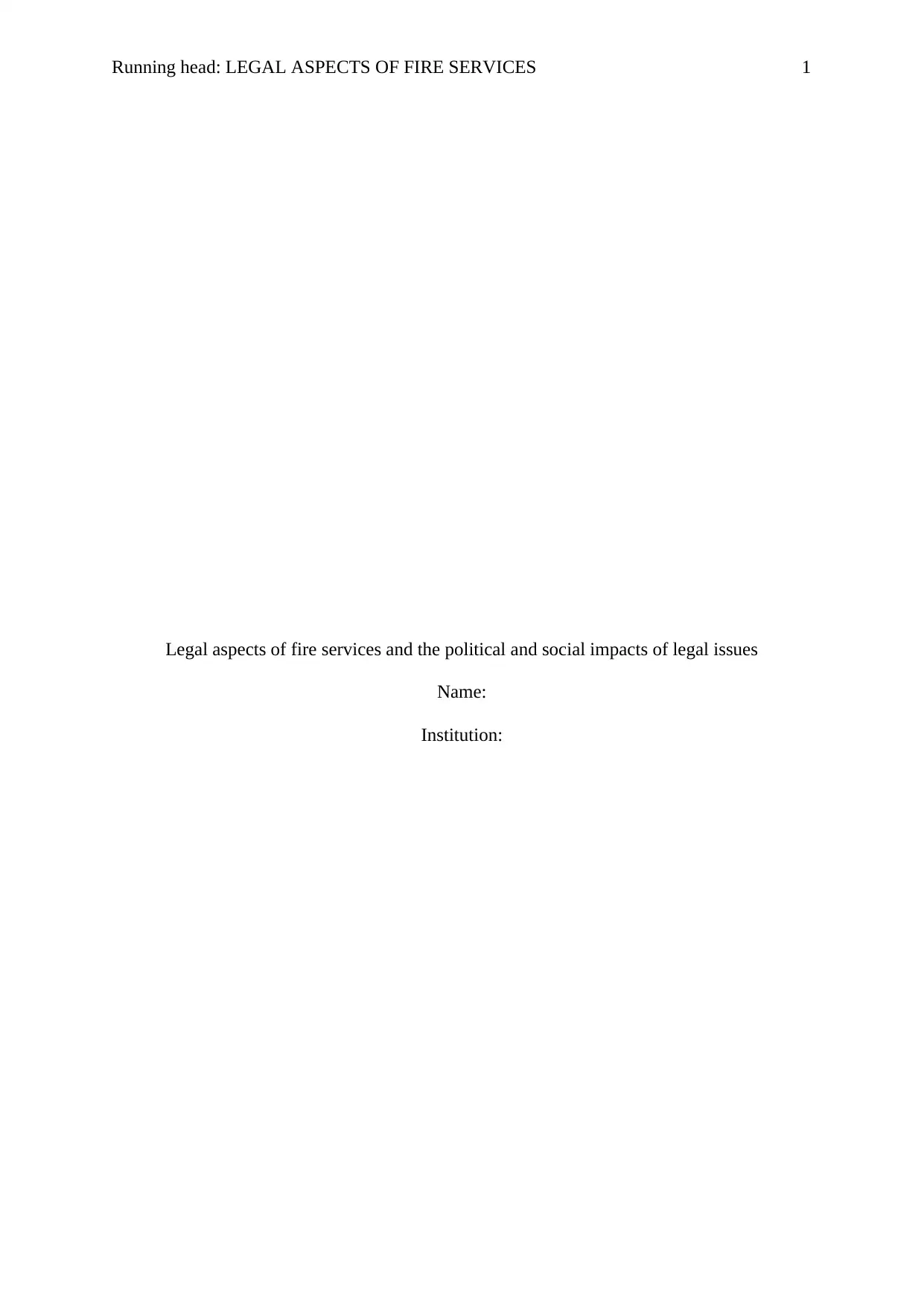
Running head: LEGAL ASPECTS OF FIRE SERVICES 1
Legal aspects of fire services and the political and social impacts of legal issues
Name:
Institution:
Legal aspects of fire services and the political and social impacts of legal issues
Name:
Institution:
Paraphrase This Document
Need a fresh take? Get an instant paraphrase of this document with our AI Paraphraser
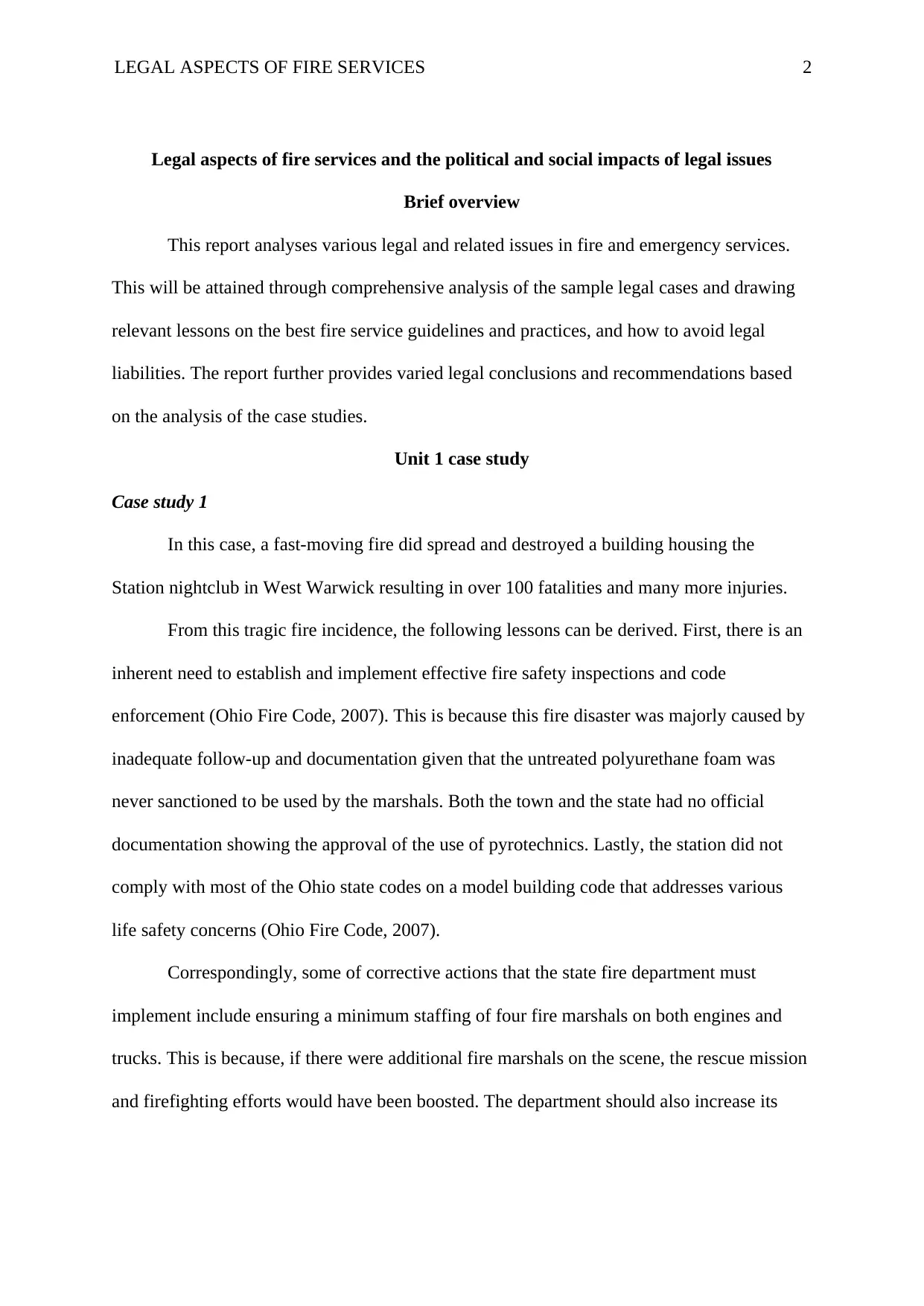
LEGAL ASPECTS OF FIRE SERVICES 2
Legal aspects of fire services and the political and social impacts of legal issues
Brief overview
This report analyses various legal and related issues in fire and emergency services.
This will be attained through comprehensive analysis of the sample legal cases and drawing
relevant lessons on the best fire service guidelines and practices, and how to avoid legal
liabilities. The report further provides varied legal conclusions and recommendations based
on the analysis of the case studies.
Unit 1 case study
Case study 1
In this case, a fast-moving fire did spread and destroyed a building housing the
Station nightclub in West Warwick resulting in over 100 fatalities and many more injuries.
From this tragic fire incidence, the following lessons can be derived. First, there is an
inherent need to establish and implement effective fire safety inspections and code
enforcement (Ohio Fire Code, 2007). This is because this fire disaster was majorly caused by
inadequate follow-up and documentation given that the untreated polyurethane foam was
never sanctioned to be used by the marshals. Both the town and the state had no official
documentation showing the approval of the use of pyrotechnics. Lastly, the station did not
comply with most of the Ohio state codes on a model building code that addresses various
life safety concerns (Ohio Fire Code, 2007).
Correspondingly, some of corrective actions that the state fire department must
implement include ensuring a minimum staffing of four fire marshals on both engines and
trucks. This is because, if there were additional fire marshals on the scene, the rescue mission
and firefighting efforts would have been boosted. The department should also increase its
Legal aspects of fire services and the political and social impacts of legal issues
Brief overview
This report analyses various legal and related issues in fire and emergency services.
This will be attained through comprehensive analysis of the sample legal cases and drawing
relevant lessons on the best fire service guidelines and practices, and how to avoid legal
liabilities. The report further provides varied legal conclusions and recommendations based
on the analysis of the case studies.
Unit 1 case study
Case study 1
In this case, a fast-moving fire did spread and destroyed a building housing the
Station nightclub in West Warwick resulting in over 100 fatalities and many more injuries.
From this tragic fire incidence, the following lessons can be derived. First, there is an
inherent need to establish and implement effective fire safety inspections and code
enforcement (Ohio Fire Code, 2007). This is because this fire disaster was majorly caused by
inadequate follow-up and documentation given that the untreated polyurethane foam was
never sanctioned to be used by the marshals. Both the town and the state had no official
documentation showing the approval of the use of pyrotechnics. Lastly, the station did not
comply with most of the Ohio state codes on a model building code that addresses various
life safety concerns (Ohio Fire Code, 2007).
Correspondingly, some of corrective actions that the state fire department must
implement include ensuring a minimum staffing of four fire marshals on both engines and
trucks. This is because, if there were additional fire marshals on the scene, the rescue mission
and firefighting efforts would have been boosted. The department should also increase its
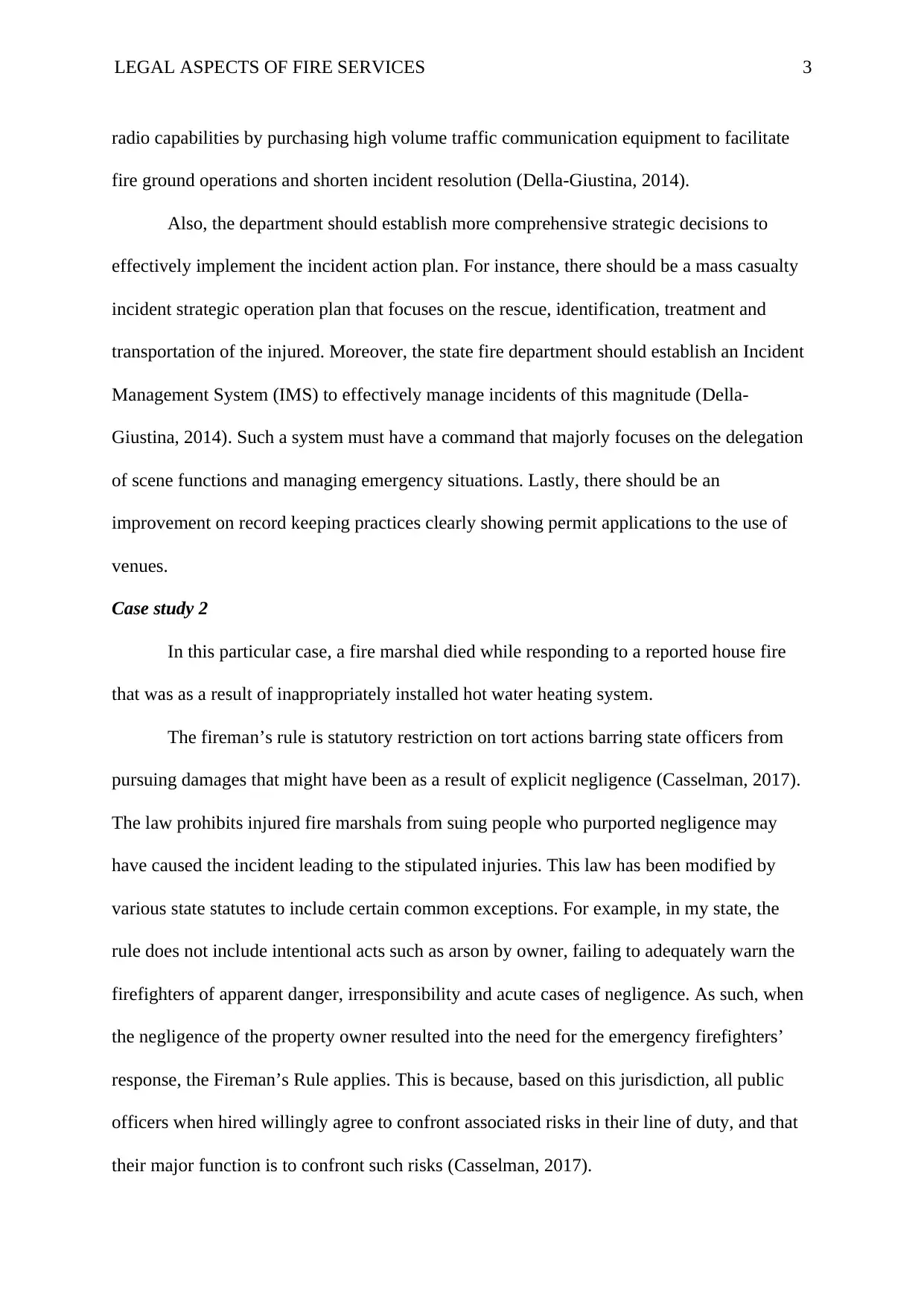
LEGAL ASPECTS OF FIRE SERVICES 3
radio capabilities by purchasing high volume traffic communication equipment to facilitate
fire ground operations and shorten incident resolution (Della-Giustina, 2014).
Also, the department should establish more comprehensive strategic decisions to
effectively implement the incident action plan. For instance, there should be a mass casualty
incident strategic operation plan that focuses on the rescue, identification, treatment and
transportation of the injured. Moreover, the state fire department should establish an Incident
Management System (IMS) to effectively manage incidents of this magnitude (Della-
Giustina, 2014). Such a system must have a command that majorly focuses on the delegation
of scene functions and managing emergency situations. Lastly, there should be an
improvement on record keeping practices clearly showing permit applications to the use of
venues.
Case study 2
In this particular case, a fire marshal died while responding to a reported house fire
that was as a result of inappropriately installed hot water heating system.
The fireman’s rule is statutory restriction on tort actions barring state officers from
pursuing damages that might have been as a result of explicit negligence (Casselman, 2017).
The law prohibits injured fire marshals from suing people who purported negligence may
have caused the incident leading to the stipulated injuries. This law has been modified by
various state statutes to include certain common exceptions. For example, in my state, the
rule does not include intentional acts such as arson by owner, failing to adequately warn the
firefighters of apparent danger, irresponsibility and acute cases of negligence. As such, when
the negligence of the property owner resulted into the need for the emergency firefighters’
response, the Fireman’s Rule applies. This is because, based on this jurisdiction, all public
officers when hired willingly agree to confront associated risks in their line of duty, and that
their major function is to confront such risks (Casselman, 2017).
radio capabilities by purchasing high volume traffic communication equipment to facilitate
fire ground operations and shorten incident resolution (Della-Giustina, 2014).
Also, the department should establish more comprehensive strategic decisions to
effectively implement the incident action plan. For instance, there should be a mass casualty
incident strategic operation plan that focuses on the rescue, identification, treatment and
transportation of the injured. Moreover, the state fire department should establish an Incident
Management System (IMS) to effectively manage incidents of this magnitude (Della-
Giustina, 2014). Such a system must have a command that majorly focuses on the delegation
of scene functions and managing emergency situations. Lastly, there should be an
improvement on record keeping practices clearly showing permit applications to the use of
venues.
Case study 2
In this particular case, a fire marshal died while responding to a reported house fire
that was as a result of inappropriately installed hot water heating system.
The fireman’s rule is statutory restriction on tort actions barring state officers from
pursuing damages that might have been as a result of explicit negligence (Casselman, 2017).
The law prohibits injured fire marshals from suing people who purported negligence may
have caused the incident leading to the stipulated injuries. This law has been modified by
various state statutes to include certain common exceptions. For example, in my state, the
rule does not include intentional acts such as arson by owner, failing to adequately warn the
firefighters of apparent danger, irresponsibility and acute cases of negligence. As such, when
the negligence of the property owner resulted into the need for the emergency firefighters’
response, the Fireman’s Rule applies. This is because, based on this jurisdiction, all public
officers when hired willingly agree to confront associated risks in their line of duty, and that
their major function is to confront such risks (Casselman, 2017).
⊘ This is a preview!⊘
Do you want full access?
Subscribe today to unlock all pages.

Trusted by 1+ million students worldwide
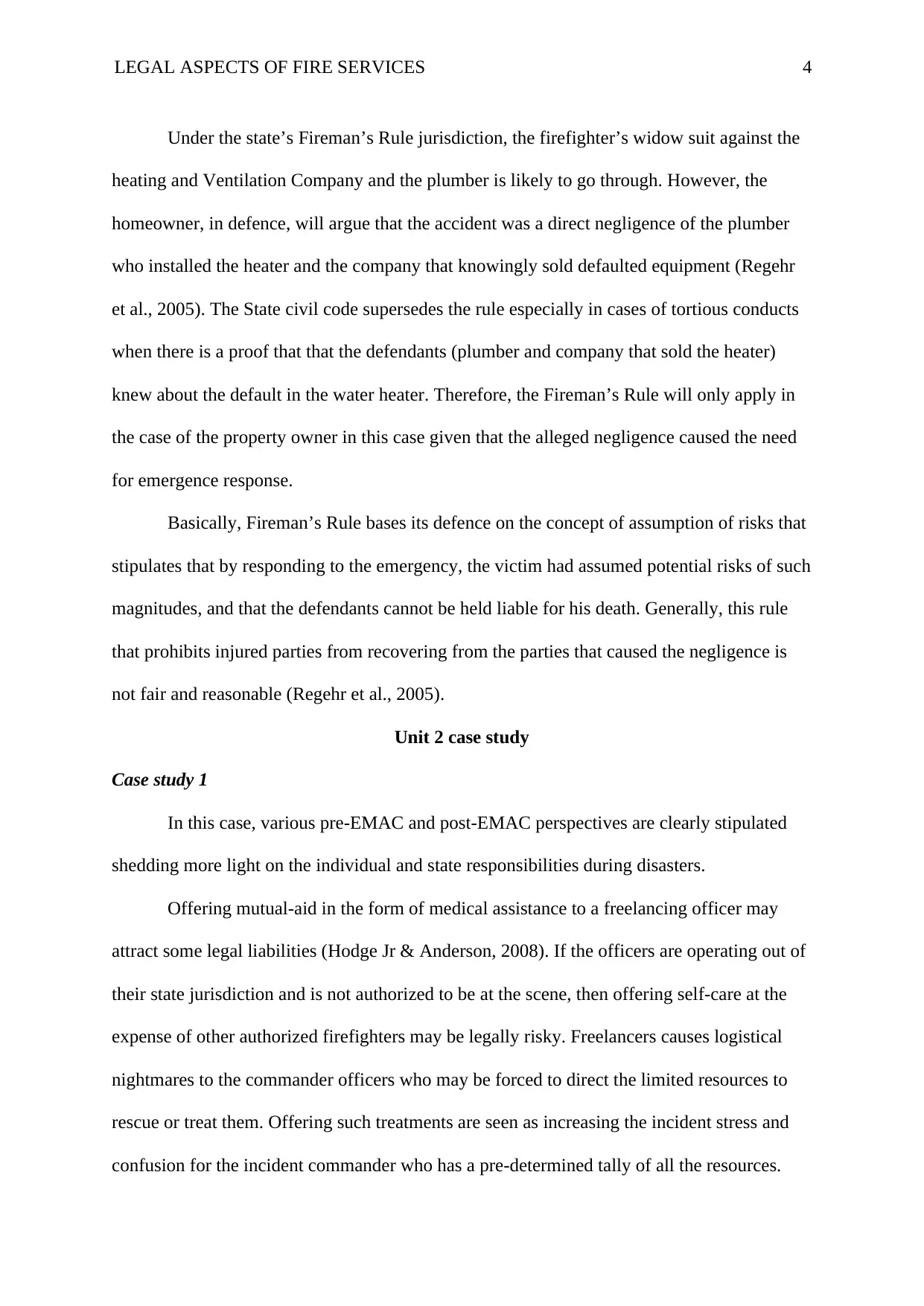
LEGAL ASPECTS OF FIRE SERVICES 4
Under the state’s Fireman’s Rule jurisdiction, the firefighter’s widow suit against the
heating and Ventilation Company and the plumber is likely to go through. However, the
homeowner, in defence, will argue that the accident was a direct negligence of the plumber
who installed the heater and the company that knowingly sold defaulted equipment (Regehr
et al., 2005). The State civil code supersedes the rule especially in cases of tortious conducts
when there is a proof that that the defendants (plumber and company that sold the heater)
knew about the default in the water heater. Therefore, the Fireman’s Rule will only apply in
the case of the property owner in this case given that the alleged negligence caused the need
for emergence response.
Basically, Fireman’s Rule bases its defence on the concept of assumption of risks that
stipulates that by responding to the emergency, the victim had assumed potential risks of such
magnitudes, and that the defendants cannot be held liable for his death. Generally, this rule
that prohibits injured parties from recovering from the parties that caused the negligence is
not fair and reasonable (Regehr et al., 2005).
Unit 2 case study
Case study 1
In this case, various pre-EMAC and post-EMAC perspectives are clearly stipulated
shedding more light on the individual and state responsibilities during disasters.
Offering mutual-aid in the form of medical assistance to a freelancing officer may
attract some legal liabilities (Hodge Jr & Anderson, 2008). If the officers are operating out of
their state jurisdiction and is not authorized to be at the scene, then offering self-care at the
expense of other authorized firefighters may be legally risky. Freelancers causes logistical
nightmares to the commander officers who may be forced to direct the limited resources to
rescue or treat them. Offering such treatments are seen as increasing the incident stress and
confusion for the incident commander who has a pre-determined tally of all the resources.
Under the state’s Fireman’s Rule jurisdiction, the firefighter’s widow suit against the
heating and Ventilation Company and the plumber is likely to go through. However, the
homeowner, in defence, will argue that the accident was a direct negligence of the plumber
who installed the heater and the company that knowingly sold defaulted equipment (Regehr
et al., 2005). The State civil code supersedes the rule especially in cases of tortious conducts
when there is a proof that that the defendants (plumber and company that sold the heater)
knew about the default in the water heater. Therefore, the Fireman’s Rule will only apply in
the case of the property owner in this case given that the alleged negligence caused the need
for emergence response.
Basically, Fireman’s Rule bases its defence on the concept of assumption of risks that
stipulates that by responding to the emergency, the victim had assumed potential risks of such
magnitudes, and that the defendants cannot be held liable for his death. Generally, this rule
that prohibits injured parties from recovering from the parties that caused the negligence is
not fair and reasonable (Regehr et al., 2005).
Unit 2 case study
Case study 1
In this case, various pre-EMAC and post-EMAC perspectives are clearly stipulated
shedding more light on the individual and state responsibilities during disasters.
Offering mutual-aid in the form of medical assistance to a freelancing officer may
attract some legal liabilities (Hodge Jr & Anderson, 2008). If the officers are operating out of
their state jurisdiction and is not authorized to be at the scene, then offering self-care at the
expense of other authorized firefighters may be legally risky. Freelancers causes logistical
nightmares to the commander officers who may be forced to direct the limited resources to
rescue or treat them. Offering such treatments are seen as increasing the incident stress and
confusion for the incident commander who has a pre-determined tally of all the resources.
Paraphrase This Document
Need a fresh take? Get an instant paraphrase of this document with our AI Paraphraser
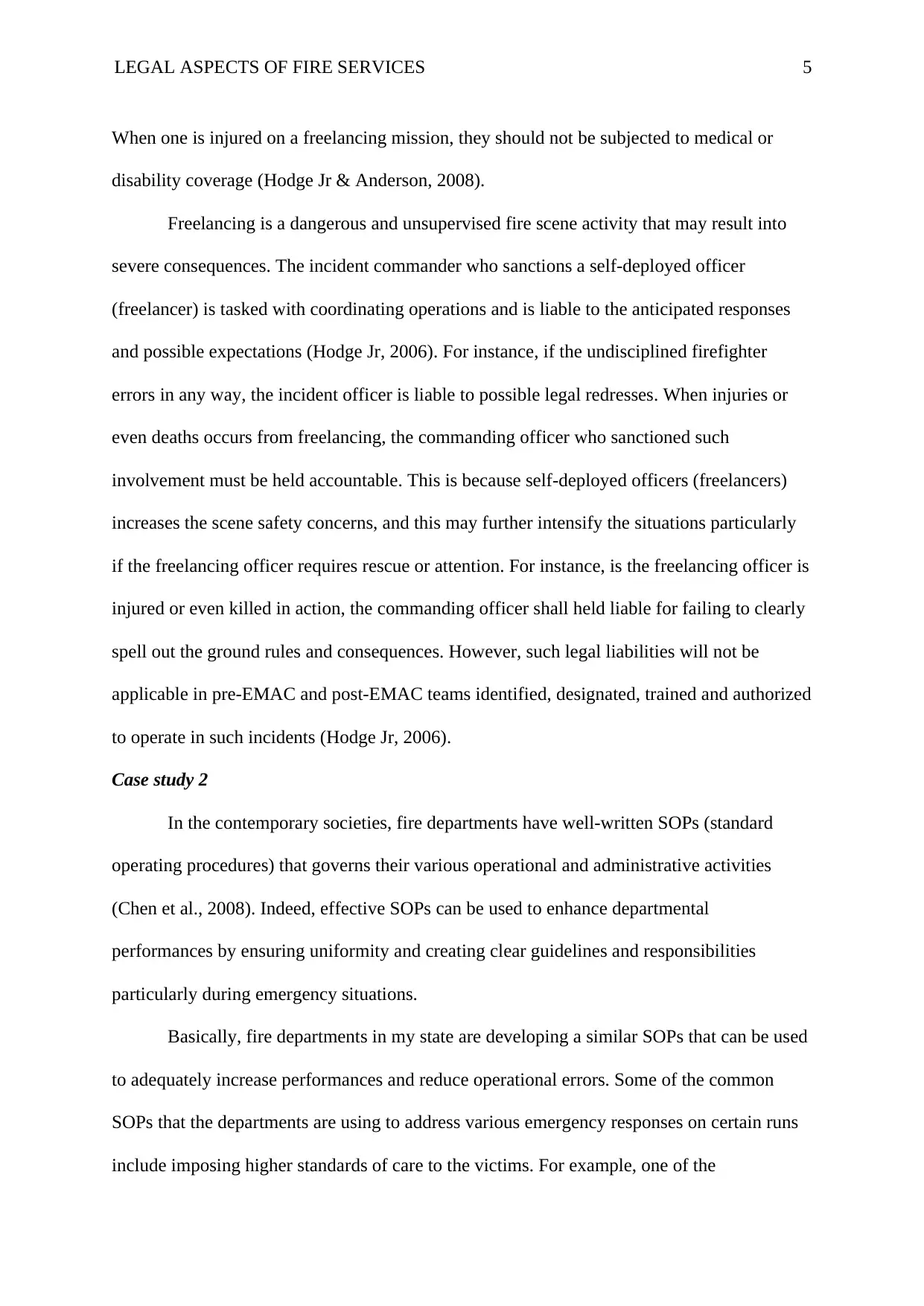
LEGAL ASPECTS OF FIRE SERVICES 5
When one is injured on a freelancing mission, they should not be subjected to medical or
disability coverage (Hodge Jr & Anderson, 2008).
Freelancing is a dangerous and unsupervised fire scene activity that may result into
severe consequences. The incident commander who sanctions a self-deployed officer
(freelancer) is tasked with coordinating operations and is liable to the anticipated responses
and possible expectations (Hodge Jr, 2006). For instance, if the undisciplined firefighter
errors in any way, the incident officer is liable to possible legal redresses. When injuries or
even deaths occurs from freelancing, the commanding officer who sanctioned such
involvement must be held accountable. This is because self-deployed officers (freelancers)
increases the scene safety concerns, and this may further intensify the situations particularly
if the freelancing officer requires rescue or attention. For instance, is the freelancing officer is
injured or even killed in action, the commanding officer shall held liable for failing to clearly
spell out the ground rules and consequences. However, such legal liabilities will not be
applicable in pre-EMAC and post-EMAC teams identified, designated, trained and authorized
to operate in such incidents (Hodge Jr, 2006).
Case study 2
In the contemporary societies, fire departments have well-written SOPs (standard
operating procedures) that governs their various operational and administrative activities
(Chen et al., 2008). Indeed, effective SOPs can be used to enhance departmental
performances by ensuring uniformity and creating clear guidelines and responsibilities
particularly during emergency situations.
Basically, fire departments in my state are developing a similar SOPs that can be used
to adequately increase performances and reduce operational errors. Some of the common
SOPs that the departments are using to address various emergency responses on certain runs
include imposing higher standards of care to the victims. For example, one of the
When one is injured on a freelancing mission, they should not be subjected to medical or
disability coverage (Hodge Jr & Anderson, 2008).
Freelancing is a dangerous and unsupervised fire scene activity that may result into
severe consequences. The incident commander who sanctions a self-deployed officer
(freelancer) is tasked with coordinating operations and is liable to the anticipated responses
and possible expectations (Hodge Jr, 2006). For instance, if the undisciplined firefighter
errors in any way, the incident officer is liable to possible legal redresses. When injuries or
even deaths occurs from freelancing, the commanding officer who sanctioned such
involvement must be held accountable. This is because self-deployed officers (freelancers)
increases the scene safety concerns, and this may further intensify the situations particularly
if the freelancing officer requires rescue or attention. For instance, is the freelancing officer is
injured or even killed in action, the commanding officer shall held liable for failing to clearly
spell out the ground rules and consequences. However, such legal liabilities will not be
applicable in pre-EMAC and post-EMAC teams identified, designated, trained and authorized
to operate in such incidents (Hodge Jr, 2006).
Case study 2
In the contemporary societies, fire departments have well-written SOPs (standard
operating procedures) that governs their various operational and administrative activities
(Chen et al., 2008). Indeed, effective SOPs can be used to enhance departmental
performances by ensuring uniformity and creating clear guidelines and responsibilities
particularly during emergency situations.
Basically, fire departments in my state are developing a similar SOPs that can be used
to adequately increase performances and reduce operational errors. Some of the common
SOPs that the departments are using to address various emergency responses on certain runs
include imposing higher standards of care to the victims. For example, one of the
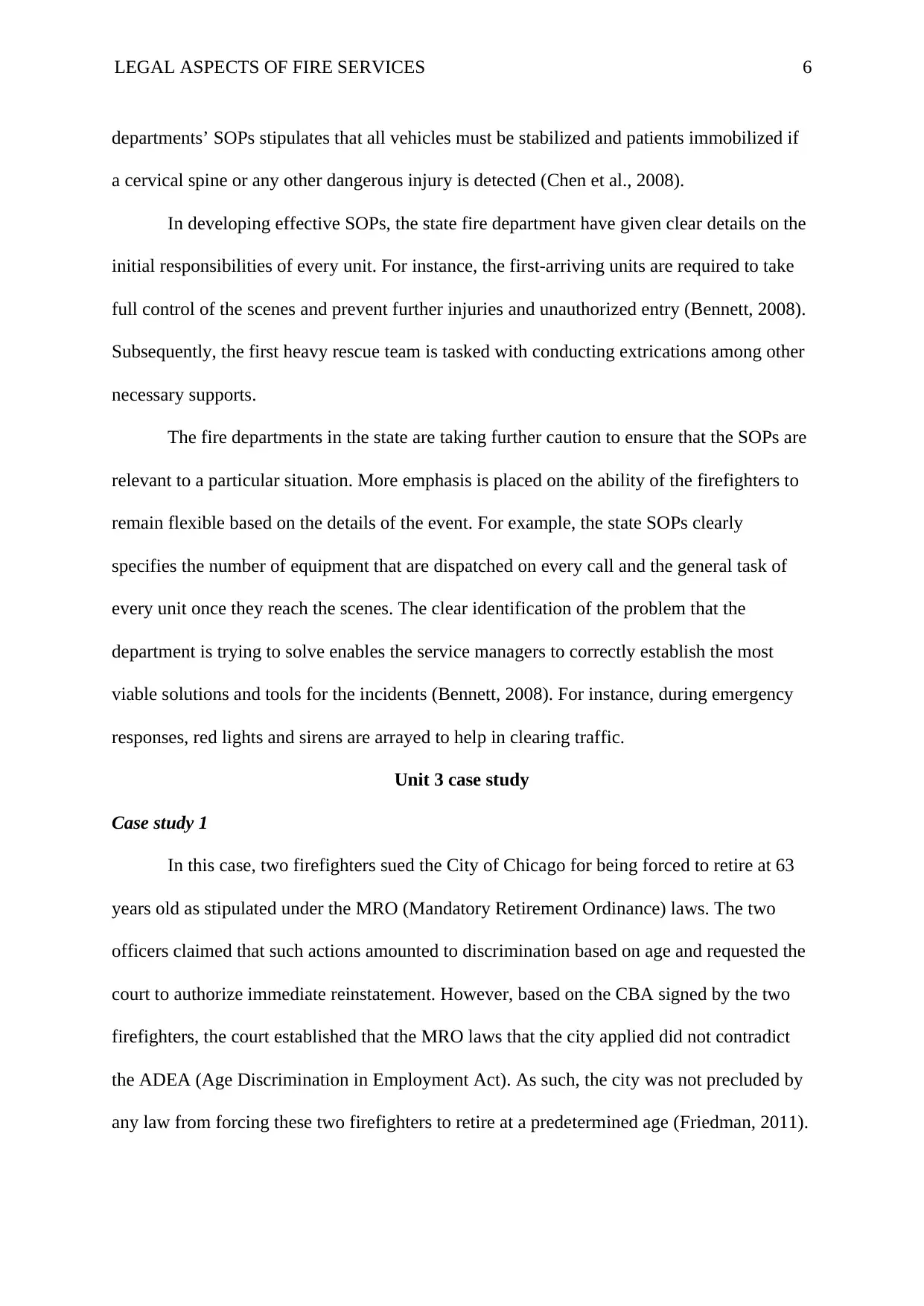
LEGAL ASPECTS OF FIRE SERVICES 6
departments’ SOPs stipulates that all vehicles must be stabilized and patients immobilized if
a cervical spine or any other dangerous injury is detected (Chen et al., 2008).
In developing effective SOPs, the state fire department have given clear details on the
initial responsibilities of every unit. For instance, the first-arriving units are required to take
full control of the scenes and prevent further injuries and unauthorized entry (Bennett, 2008).
Subsequently, the first heavy rescue team is tasked with conducting extrications among other
necessary supports.
The fire departments in the state are taking further caution to ensure that the SOPs are
relevant to a particular situation. More emphasis is placed on the ability of the firefighters to
remain flexible based on the details of the event. For example, the state SOPs clearly
specifies the number of equipment that are dispatched on every call and the general task of
every unit once they reach the scenes. The clear identification of the problem that the
department is trying to solve enables the service managers to correctly establish the most
viable solutions and tools for the incidents (Bennett, 2008). For instance, during emergency
responses, red lights and sirens are arrayed to help in clearing traffic.
Unit 3 case study
Case study 1
In this case, two firefighters sued the City of Chicago for being forced to retire at 63
years old as stipulated under the MRO (Mandatory Retirement Ordinance) laws. The two
officers claimed that such actions amounted to discrimination based on age and requested the
court to authorize immediate reinstatement. However, based on the CBA signed by the two
firefighters, the court established that the MRO laws that the city applied did not contradict
the ADEA (Age Discrimination in Employment Act). As such, the city was not precluded by
any law from forcing these two firefighters to retire at a predetermined age (Friedman, 2011).
departments’ SOPs stipulates that all vehicles must be stabilized and patients immobilized if
a cervical spine or any other dangerous injury is detected (Chen et al., 2008).
In developing effective SOPs, the state fire department have given clear details on the
initial responsibilities of every unit. For instance, the first-arriving units are required to take
full control of the scenes and prevent further injuries and unauthorized entry (Bennett, 2008).
Subsequently, the first heavy rescue team is tasked with conducting extrications among other
necessary supports.
The fire departments in the state are taking further caution to ensure that the SOPs are
relevant to a particular situation. More emphasis is placed on the ability of the firefighters to
remain flexible based on the details of the event. For example, the state SOPs clearly
specifies the number of equipment that are dispatched on every call and the general task of
every unit once they reach the scenes. The clear identification of the problem that the
department is trying to solve enables the service managers to correctly establish the most
viable solutions and tools for the incidents (Bennett, 2008). For instance, during emergency
responses, red lights and sirens are arrayed to help in clearing traffic.
Unit 3 case study
Case study 1
In this case, two firefighters sued the City of Chicago for being forced to retire at 63
years old as stipulated under the MRO (Mandatory Retirement Ordinance) laws. The two
officers claimed that such actions amounted to discrimination based on age and requested the
court to authorize immediate reinstatement. However, based on the CBA signed by the two
firefighters, the court established that the MRO laws that the city applied did not contradict
the ADEA (Age Discrimination in Employment Act). As such, the city was not precluded by
any law from forcing these two firefighters to retire at a predetermined age (Friedman, 2011).
⊘ This is a preview!⊘
Do you want full access?
Subscribe today to unlock all pages.

Trusted by 1+ million students worldwide
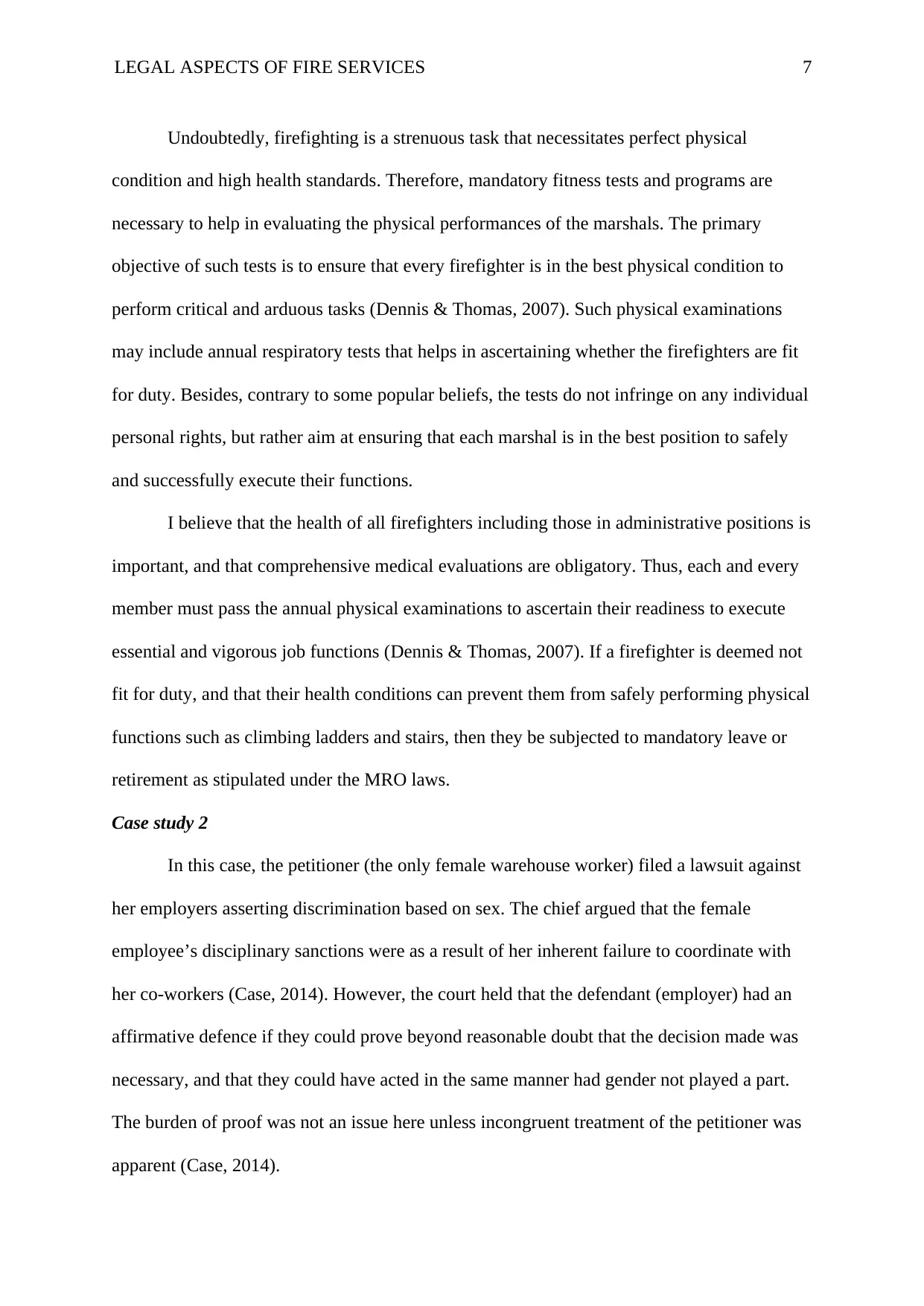
LEGAL ASPECTS OF FIRE SERVICES 7
Undoubtedly, firefighting is a strenuous task that necessitates perfect physical
condition and high health standards. Therefore, mandatory fitness tests and programs are
necessary to help in evaluating the physical performances of the marshals. The primary
objective of such tests is to ensure that every firefighter is in the best physical condition to
perform critical and arduous tasks (Dennis & Thomas, 2007). Such physical examinations
may include annual respiratory tests that helps in ascertaining whether the firefighters are fit
for duty. Besides, contrary to some popular beliefs, the tests do not infringe on any individual
personal rights, but rather aim at ensuring that each marshal is in the best position to safely
and successfully execute their functions.
I believe that the health of all firefighters including those in administrative positions is
important, and that comprehensive medical evaluations are obligatory. Thus, each and every
member must pass the annual physical examinations to ascertain their readiness to execute
essential and vigorous job functions (Dennis & Thomas, 2007). If a firefighter is deemed not
fit for duty, and that their health conditions can prevent them from safely performing physical
functions such as climbing ladders and stairs, then they be subjected to mandatory leave or
retirement as stipulated under the MRO laws.
Case study 2
In this case, the petitioner (the only female warehouse worker) filed a lawsuit against
her employers asserting discrimination based on sex. The chief argued that the female
employee’s disciplinary sanctions were as a result of her inherent failure to coordinate with
her co-workers (Case, 2014). However, the court held that the defendant (employer) had an
affirmative defence if they could prove beyond reasonable doubt that the decision made was
necessary, and that they could have acted in the same manner had gender not played a part.
The burden of proof was not an issue here unless incongruent treatment of the petitioner was
apparent (Case, 2014).
Undoubtedly, firefighting is a strenuous task that necessitates perfect physical
condition and high health standards. Therefore, mandatory fitness tests and programs are
necessary to help in evaluating the physical performances of the marshals. The primary
objective of such tests is to ensure that every firefighter is in the best physical condition to
perform critical and arduous tasks (Dennis & Thomas, 2007). Such physical examinations
may include annual respiratory tests that helps in ascertaining whether the firefighters are fit
for duty. Besides, contrary to some popular beliefs, the tests do not infringe on any individual
personal rights, but rather aim at ensuring that each marshal is in the best position to safely
and successfully execute their functions.
I believe that the health of all firefighters including those in administrative positions is
important, and that comprehensive medical evaluations are obligatory. Thus, each and every
member must pass the annual physical examinations to ascertain their readiness to execute
essential and vigorous job functions (Dennis & Thomas, 2007). If a firefighter is deemed not
fit for duty, and that their health conditions can prevent them from safely performing physical
functions such as climbing ladders and stairs, then they be subjected to mandatory leave or
retirement as stipulated under the MRO laws.
Case study 2
In this case, the petitioner (the only female warehouse worker) filed a lawsuit against
her employers asserting discrimination based on sex. The chief argued that the female
employee’s disciplinary sanctions were as a result of her inherent failure to coordinate with
her co-workers (Case, 2014). However, the court held that the defendant (employer) had an
affirmative defence if they could prove beyond reasonable doubt that the decision made was
necessary, and that they could have acted in the same manner had gender not played a part.
The burden of proof was not an issue here unless incongruent treatment of the petitioner was
apparent (Case, 2014).
Paraphrase This Document
Need a fresh take? Get an instant paraphrase of this document with our AI Paraphraser
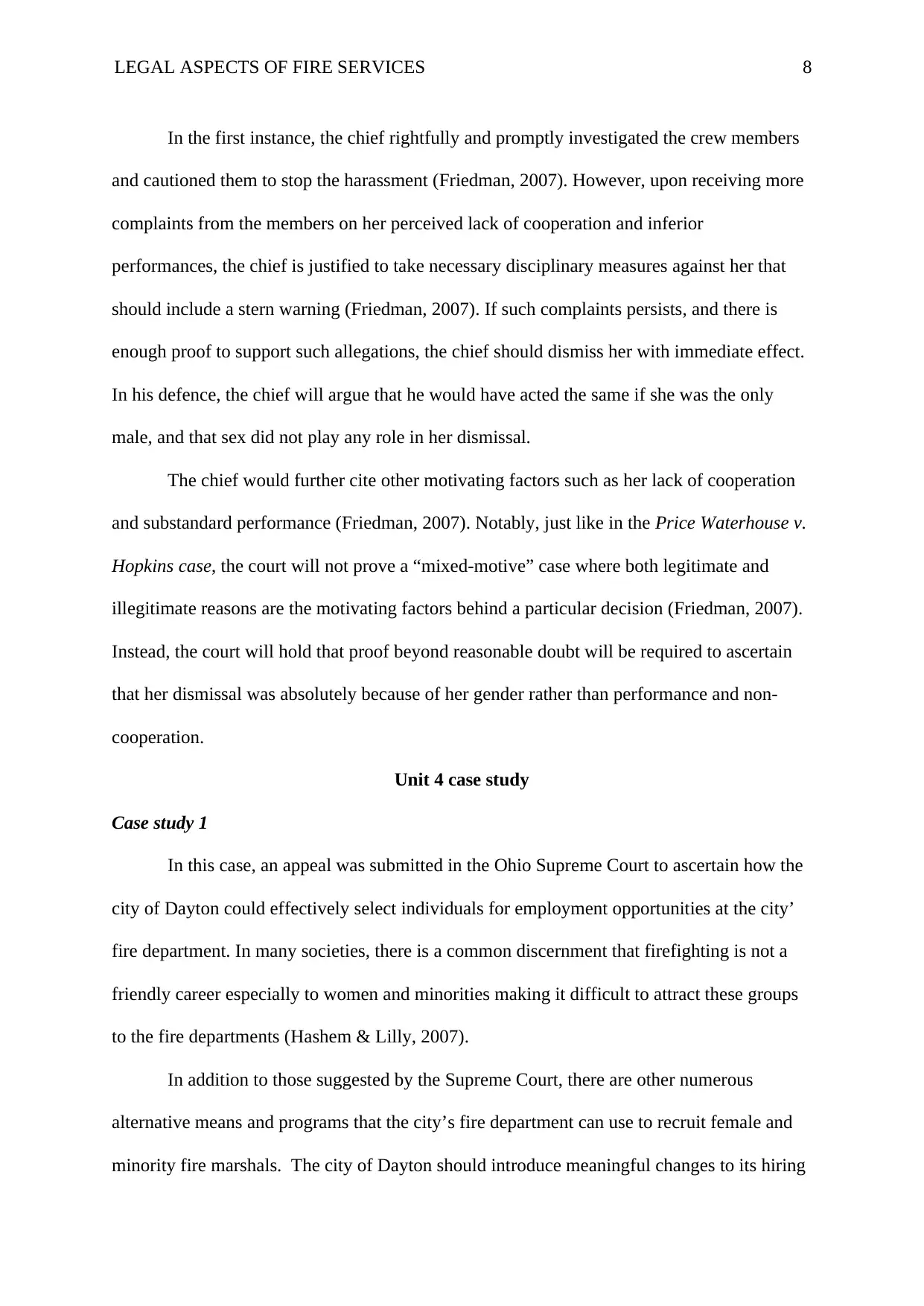
LEGAL ASPECTS OF FIRE SERVICES 8
In the first instance, the chief rightfully and promptly investigated the crew members
and cautioned them to stop the harassment (Friedman, 2007). However, upon receiving more
complaints from the members on her perceived lack of cooperation and inferior
performances, the chief is justified to take necessary disciplinary measures against her that
should include a stern warning (Friedman, 2007). If such complaints persists, and there is
enough proof to support such allegations, the chief should dismiss her with immediate effect.
In his defence, the chief will argue that he would have acted the same if she was the only
male, and that sex did not play any role in her dismissal.
The chief would further cite other motivating factors such as her lack of cooperation
and substandard performance (Friedman, 2007). Notably, just like in the Price Waterhouse v.
Hopkins case, the court will not prove a “mixed-motive” case where both legitimate and
illegitimate reasons are the motivating factors behind a particular decision (Friedman, 2007).
Instead, the court will hold that proof beyond reasonable doubt will be required to ascertain
that her dismissal was absolutely because of her gender rather than performance and non-
cooperation.
Unit 4 case study
Case study 1
In this case, an appeal was submitted in the Ohio Supreme Court to ascertain how the
city of Dayton could effectively select individuals for employment opportunities at the city’
fire department. In many societies, there is a common discernment that firefighting is not a
friendly career especially to women and minorities making it difficult to attract these groups
to the fire departments (Hashem & Lilly, 2007).
In addition to those suggested by the Supreme Court, there are other numerous
alternative means and programs that the city’s fire department can use to recruit female and
minority fire marshals. The city of Dayton should introduce meaningful changes to its hiring
In the first instance, the chief rightfully and promptly investigated the crew members
and cautioned them to stop the harassment (Friedman, 2007). However, upon receiving more
complaints from the members on her perceived lack of cooperation and inferior
performances, the chief is justified to take necessary disciplinary measures against her that
should include a stern warning (Friedman, 2007). If such complaints persists, and there is
enough proof to support such allegations, the chief should dismiss her with immediate effect.
In his defence, the chief will argue that he would have acted the same if she was the only
male, and that sex did not play any role in her dismissal.
The chief would further cite other motivating factors such as her lack of cooperation
and substandard performance (Friedman, 2007). Notably, just like in the Price Waterhouse v.
Hopkins case, the court will not prove a “mixed-motive” case where both legitimate and
illegitimate reasons are the motivating factors behind a particular decision (Friedman, 2007).
Instead, the court will hold that proof beyond reasonable doubt will be required to ascertain
that her dismissal was absolutely because of her gender rather than performance and non-
cooperation.
Unit 4 case study
Case study 1
In this case, an appeal was submitted in the Ohio Supreme Court to ascertain how the
city of Dayton could effectively select individuals for employment opportunities at the city’
fire department. In many societies, there is a common discernment that firefighting is not a
friendly career especially to women and minorities making it difficult to attract these groups
to the fire departments (Hashem & Lilly, 2007).
In addition to those suggested by the Supreme Court, there are other numerous
alternative means and programs that the city’s fire department can use to recruit female and
minority fire marshals. The city of Dayton should introduce meaningful changes to its hiring
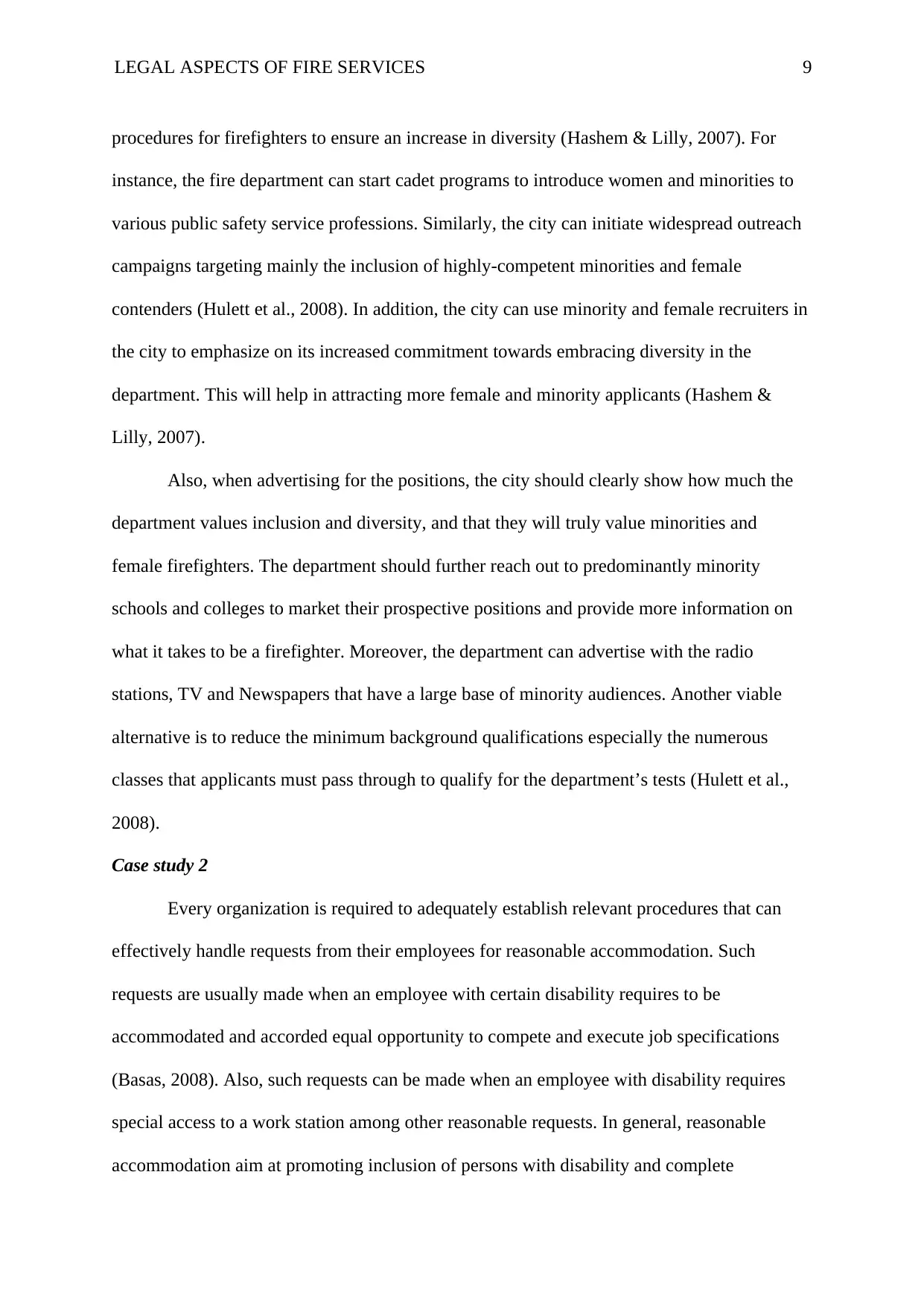
LEGAL ASPECTS OF FIRE SERVICES 9
procedures for firefighters to ensure an increase in diversity (Hashem & Lilly, 2007). For
instance, the fire department can start cadet programs to introduce women and minorities to
various public safety service professions. Similarly, the city can initiate widespread outreach
campaigns targeting mainly the inclusion of highly-competent minorities and female
contenders (Hulett et al., 2008). In addition, the city can use minority and female recruiters in
the city to emphasize on its increased commitment towards embracing diversity in the
department. This will help in attracting more female and minority applicants (Hashem &
Lilly, 2007).
Also, when advertising for the positions, the city should clearly show how much the
department values inclusion and diversity, and that they will truly value minorities and
female firefighters. The department should further reach out to predominantly minority
schools and colleges to market their prospective positions and provide more information on
what it takes to be a firefighter. Moreover, the department can advertise with the radio
stations, TV and Newspapers that have a large base of minority audiences. Another viable
alternative is to reduce the minimum background qualifications especially the numerous
classes that applicants must pass through to qualify for the department’s tests (Hulett et al.,
2008).
Case study 2
Every organization is required to adequately establish relevant procedures that can
effectively handle requests from their employees for reasonable accommodation. Such
requests are usually made when an employee with certain disability requires to be
accommodated and accorded equal opportunity to compete and execute job specifications
(Basas, 2008). Also, such requests can be made when an employee with disability requires
special access to a work station among other reasonable requests. In general, reasonable
accommodation aim at promoting inclusion of persons with disability and complete
procedures for firefighters to ensure an increase in diversity (Hashem & Lilly, 2007). For
instance, the fire department can start cadet programs to introduce women and minorities to
various public safety service professions. Similarly, the city can initiate widespread outreach
campaigns targeting mainly the inclusion of highly-competent minorities and female
contenders (Hulett et al., 2008). In addition, the city can use minority and female recruiters in
the city to emphasize on its increased commitment towards embracing diversity in the
department. This will help in attracting more female and minority applicants (Hashem &
Lilly, 2007).
Also, when advertising for the positions, the city should clearly show how much the
department values inclusion and diversity, and that they will truly value minorities and
female firefighters. The department should further reach out to predominantly minority
schools and colleges to market their prospective positions and provide more information on
what it takes to be a firefighter. Moreover, the department can advertise with the radio
stations, TV and Newspapers that have a large base of minority audiences. Another viable
alternative is to reduce the minimum background qualifications especially the numerous
classes that applicants must pass through to qualify for the department’s tests (Hulett et al.,
2008).
Case study 2
Every organization is required to adequately establish relevant procedures that can
effectively handle requests from their employees for reasonable accommodation. Such
requests are usually made when an employee with certain disability requires to be
accommodated and accorded equal opportunity to compete and execute job specifications
(Basas, 2008). Also, such requests can be made when an employee with disability requires
special access to a work station among other reasonable requests. In general, reasonable
accommodation aim at promoting inclusion of persons with disability and complete
⊘ This is a preview!⊘
Do you want full access?
Subscribe today to unlock all pages.

Trusted by 1+ million students worldwide
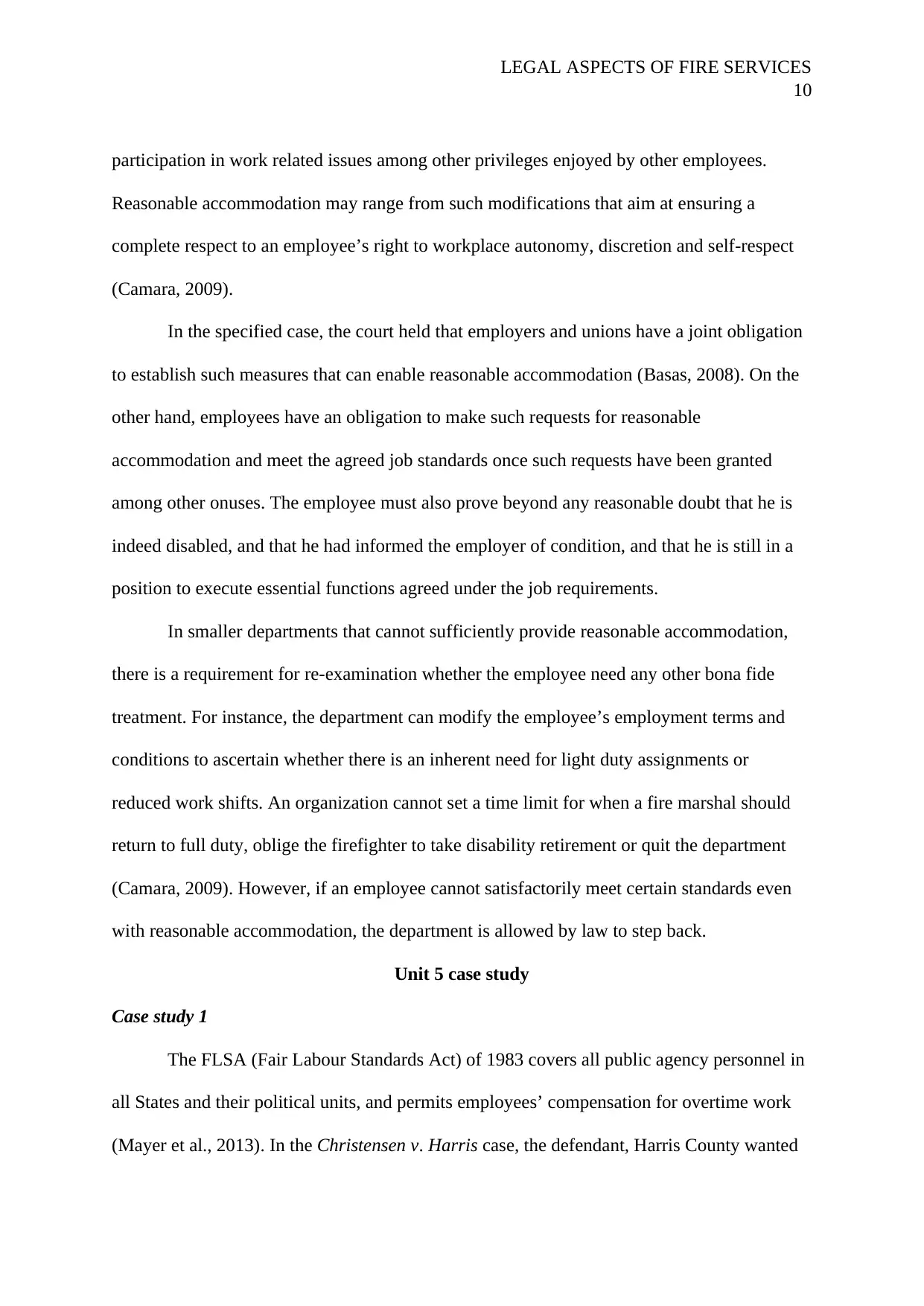
LEGAL ASPECTS OF FIRE SERVICES
10
participation in work related issues among other privileges enjoyed by other employees.
Reasonable accommodation may range from such modifications that aim at ensuring a
complete respect to an employee’s right to workplace autonomy, discretion and self-respect
(Camara, 2009).
In the specified case, the court held that employers and unions have a joint obligation
to establish such measures that can enable reasonable accommodation (Basas, 2008). On the
other hand, employees have an obligation to make such requests for reasonable
accommodation and meet the agreed job standards once such requests have been granted
among other onuses. The employee must also prove beyond any reasonable doubt that he is
indeed disabled, and that he had informed the employer of condition, and that he is still in a
position to execute essential functions agreed under the job requirements.
In smaller departments that cannot sufficiently provide reasonable accommodation,
there is a requirement for re-examination whether the employee need any other bona fide
treatment. For instance, the department can modify the employee’s employment terms and
conditions to ascertain whether there is an inherent need for light duty assignments or
reduced work shifts. An organization cannot set a time limit for when a fire marshal should
return to full duty, oblige the firefighter to take disability retirement or quit the department
(Camara, 2009). However, if an employee cannot satisfactorily meet certain standards even
with reasonable accommodation, the department is allowed by law to step back.
Unit 5 case study
Case study 1
The FLSA (Fair Labour Standards Act) of 1983 covers all public agency personnel in
all States and their political units, and permits employees’ compensation for overtime work
(Mayer et al., 2013). In the Christensen v. Harris case, the defendant, Harris County wanted
10
participation in work related issues among other privileges enjoyed by other employees.
Reasonable accommodation may range from such modifications that aim at ensuring a
complete respect to an employee’s right to workplace autonomy, discretion and self-respect
(Camara, 2009).
In the specified case, the court held that employers and unions have a joint obligation
to establish such measures that can enable reasonable accommodation (Basas, 2008). On the
other hand, employees have an obligation to make such requests for reasonable
accommodation and meet the agreed job standards once such requests have been granted
among other onuses. The employee must also prove beyond any reasonable doubt that he is
indeed disabled, and that he had informed the employer of condition, and that he is still in a
position to execute essential functions agreed under the job requirements.
In smaller departments that cannot sufficiently provide reasonable accommodation,
there is a requirement for re-examination whether the employee need any other bona fide
treatment. For instance, the department can modify the employee’s employment terms and
conditions to ascertain whether there is an inherent need for light duty assignments or
reduced work shifts. An organization cannot set a time limit for when a fire marshal should
return to full duty, oblige the firefighter to take disability retirement or quit the department
(Camara, 2009). However, if an employee cannot satisfactorily meet certain standards even
with reasonable accommodation, the department is allowed by law to step back.
Unit 5 case study
Case study 1
The FLSA (Fair Labour Standards Act) of 1983 covers all public agency personnel in
all States and their political units, and permits employees’ compensation for overtime work
(Mayer et al., 2013). In the Christensen v. Harris case, the defendant, Harris County wanted
Paraphrase This Document
Need a fresh take? Get an instant paraphrase of this document with our AI Paraphraser
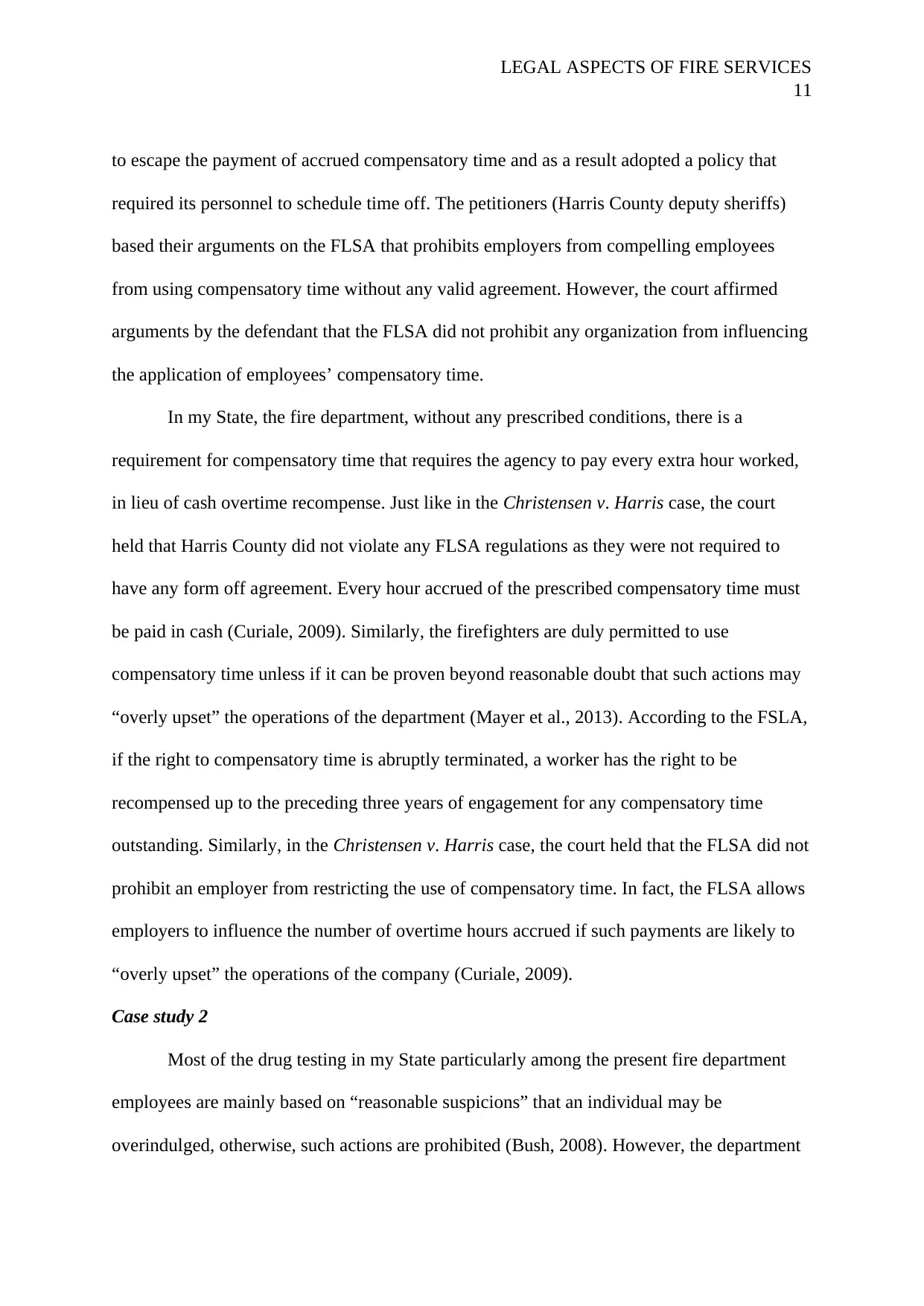
LEGAL ASPECTS OF FIRE SERVICES
11
to escape the payment of accrued compensatory time and as a result adopted a policy that
required its personnel to schedule time off. The petitioners (Harris County deputy sheriffs)
based their arguments on the FLSA that prohibits employers from compelling employees
from using compensatory time without any valid agreement. However, the court affirmed
arguments by the defendant that the FLSA did not prohibit any organization from influencing
the application of employees’ compensatory time.
In my State, the fire department, without any prescribed conditions, there is a
requirement for compensatory time that requires the agency to pay every extra hour worked,
in lieu of cash overtime recompense. Just like in the Christensen v. Harris case, the court
held that Harris County did not violate any FLSA regulations as they were not required to
have any form off agreement. Every hour accrued of the prescribed compensatory time must
be paid in cash (Curiale, 2009). Similarly, the firefighters are duly permitted to use
compensatory time unless if it can be proven beyond reasonable doubt that such actions may
“overly upset” the operations of the department (Mayer et al., 2013). According to the FSLA,
if the right to compensatory time is abruptly terminated, a worker has the right to be
recompensed up to the preceding three years of engagement for any compensatory time
outstanding. Similarly, in the Christensen v. Harris case, the court held that the FLSA did not
prohibit an employer from restricting the use of compensatory time. In fact, the FLSA allows
employers to influence the number of overtime hours accrued if such payments are likely to
“overly upset” the operations of the company (Curiale, 2009).
Case study 2
Most of the drug testing in my State particularly among the present fire department
employees are mainly based on “reasonable suspicions” that an individual may be
overindulged, otherwise, such actions are prohibited (Bush, 2008). However, the department
11
to escape the payment of accrued compensatory time and as a result adopted a policy that
required its personnel to schedule time off. The petitioners (Harris County deputy sheriffs)
based their arguments on the FLSA that prohibits employers from compelling employees
from using compensatory time without any valid agreement. However, the court affirmed
arguments by the defendant that the FLSA did not prohibit any organization from influencing
the application of employees’ compensatory time.
In my State, the fire department, without any prescribed conditions, there is a
requirement for compensatory time that requires the agency to pay every extra hour worked,
in lieu of cash overtime recompense. Just like in the Christensen v. Harris case, the court
held that Harris County did not violate any FLSA regulations as they were not required to
have any form off agreement. Every hour accrued of the prescribed compensatory time must
be paid in cash (Curiale, 2009). Similarly, the firefighters are duly permitted to use
compensatory time unless if it can be proven beyond reasonable doubt that such actions may
“overly upset” the operations of the department (Mayer et al., 2013). According to the FSLA,
if the right to compensatory time is abruptly terminated, a worker has the right to be
recompensed up to the preceding three years of engagement for any compensatory time
outstanding. Similarly, in the Christensen v. Harris case, the court held that the FLSA did not
prohibit an employer from restricting the use of compensatory time. In fact, the FLSA allows
employers to influence the number of overtime hours accrued if such payments are likely to
“overly upset” the operations of the company (Curiale, 2009).
Case study 2
Most of the drug testing in my State particularly among the present fire department
employees are mainly based on “reasonable suspicions” that an individual may be
overindulged, otherwise, such actions are prohibited (Bush, 2008). However, the department
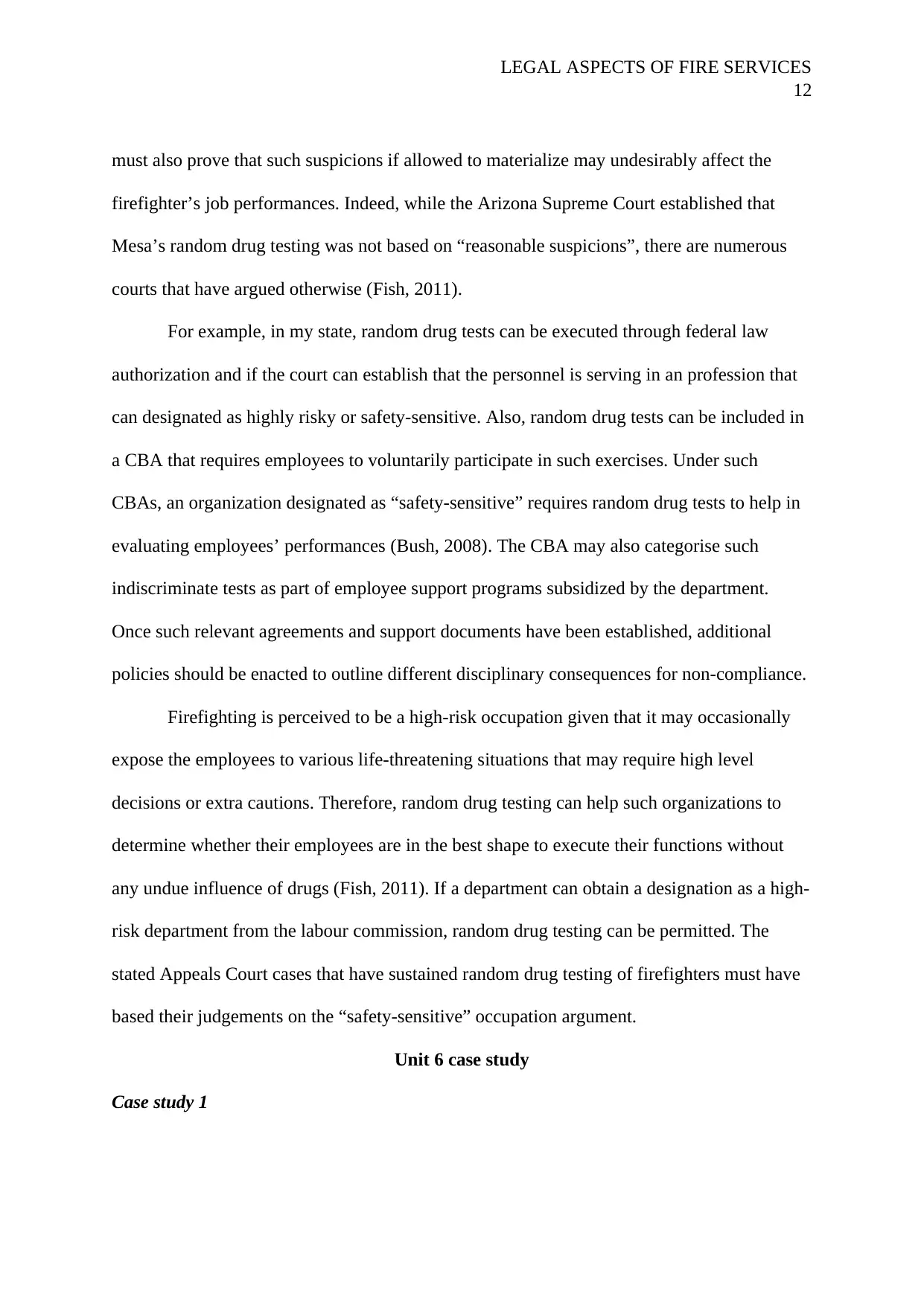
LEGAL ASPECTS OF FIRE SERVICES
12
must also prove that such suspicions if allowed to materialize may undesirably affect the
firefighter’s job performances. Indeed, while the Arizona Supreme Court established that
Mesa’s random drug testing was not based on “reasonable suspicions”, there are numerous
courts that have argued otherwise (Fish, 2011).
For example, in my state, random drug tests can be executed through federal law
authorization and if the court can establish that the personnel is serving in an profession that
can designated as highly risky or safety-sensitive. Also, random drug tests can be included in
a CBA that requires employees to voluntarily participate in such exercises. Under such
CBAs, an organization designated as “safety-sensitive” requires random drug tests to help in
evaluating employees’ performances (Bush, 2008). The CBA may also categorise such
indiscriminate tests as part of employee support programs subsidized by the department.
Once such relevant agreements and support documents have been established, additional
policies should be enacted to outline different disciplinary consequences for non-compliance.
Firefighting is perceived to be a high-risk occupation given that it may occasionally
expose the employees to various life-threatening situations that may require high level
decisions or extra cautions. Therefore, random drug testing can help such organizations to
determine whether their employees are in the best shape to execute their functions without
any undue influence of drugs (Fish, 2011). If a department can obtain a designation as a high-
risk department from the labour commission, random drug testing can be permitted. The
stated Appeals Court cases that have sustained random drug testing of firefighters must have
based their judgements on the “safety-sensitive” occupation argument.
Unit 6 case study
Case study 1
12
must also prove that such suspicions if allowed to materialize may undesirably affect the
firefighter’s job performances. Indeed, while the Arizona Supreme Court established that
Mesa’s random drug testing was not based on “reasonable suspicions”, there are numerous
courts that have argued otherwise (Fish, 2011).
For example, in my state, random drug tests can be executed through federal law
authorization and if the court can establish that the personnel is serving in an profession that
can designated as highly risky or safety-sensitive. Also, random drug tests can be included in
a CBA that requires employees to voluntarily participate in such exercises. Under such
CBAs, an organization designated as “safety-sensitive” requires random drug tests to help in
evaluating employees’ performances (Bush, 2008). The CBA may also categorise such
indiscriminate tests as part of employee support programs subsidized by the department.
Once such relevant agreements and support documents have been established, additional
policies should be enacted to outline different disciplinary consequences for non-compliance.
Firefighting is perceived to be a high-risk occupation given that it may occasionally
expose the employees to various life-threatening situations that may require high level
decisions or extra cautions. Therefore, random drug testing can help such organizations to
determine whether their employees are in the best shape to execute their functions without
any undue influence of drugs (Fish, 2011). If a department can obtain a designation as a high-
risk department from the labour commission, random drug testing can be permitted. The
stated Appeals Court cases that have sustained random drug testing of firefighters must have
based their judgements on the “safety-sensitive” occupation argument.
Unit 6 case study
Case study 1
⊘ This is a preview!⊘
Do you want full access?
Subscribe today to unlock all pages.

Trusted by 1+ million students worldwide
1 out of 23
Your All-in-One AI-Powered Toolkit for Academic Success.
+13062052269
info@desklib.com
Available 24*7 on WhatsApp / Email
![[object Object]](/_next/static/media/star-bottom.7253800d.svg)
Unlock your academic potential
Copyright © 2020–2025 A2Z Services. All Rights Reserved. Developed and managed by ZUCOL.